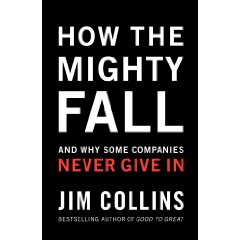
Jim Collins is one of the great business authors of our time. Starting with Built to Last, moving on to Good to Great and now a quick stopover with How the Mighty Fall Collins has cemented his reputation. I say quick stopover because Collins had only intended this to be an article, but when he saw its importance he expanded it into a short book. Do not let the length prejudice your view of its quality.
Two of the “great companies” from Good to Great Circuit City have gone from good to defunct, Circuit City, or in the case of Fannie Mae good to so pathetic it needed to be bailed out by the government. Does this mean the lessons from GTG are invalid? By studying the decline and demise of these companies we can learn more from failure than success. This is proven by the five stages of this disease called failure.
Stage 1: Hubris born of success, the definition of hubris can be simplified in the term arrogance. In Greek terminology it described the self induced fall of the hero. In business it means that due to previous success the company believes it cannot fail. The company believes it is entitled to success. This leads to the second stage.
Stage 2: Undisciplined pursuit of more. A few clues that the company is in this stage includes a strong cash position eroding cost discipline. This usually leads to the belief that more sales fix all problems. The company confuses being big with being great. Many large companies in our industry that focus on apartment cleaning can easily slip into this.Then stage 3 is inevitable.
Stage 3: Denial of risk and peril. Companies that look for massive volume such as a total focus on apartments or restaurant cleaning or restoration companies that receive the majority of business from one insurance company can be devastated by one change. This recently happened as Darden Restaurants (Red Lobster, Olive Garden, Longhorn Steakhouse) signed an exclusive national contract with Stanley Steemer. This move seriously hurt several independent cleaners who had a high percentage of their business with the chain.
Stage 4: Grasping for salvation. In many cases this leads to price discounting or restructuring of the company searching for the silver bullet.
Stage 5: Capitulation to irrelevance or death. I believe this needs no explanation.
Collins has always stressed “getting the right people on the bus in the right seats.”
The appendices are the most interesting part of the book. They give examples of companies such as Nordstroms that were in stage 4 but rebounded. Collins uses the framework of the GTG principles to explain the comeback.
Blake Nordstrom, a fourth generation Nordstrom, exemplified the principles of level five leadership. In other words stressing the health of the company over any personal gain.
Collins has always stressed “getting the right people on the bus in the right seats.” Nordstrom re-embraced the idea of hiring people based on values and character, not skills. Nordstrom employees follow the mantra of developing customer relationships. The management team invested in new inventory systems which gave the salesteam tools to simplify their jobs.
For the “hedgehog concept” it was a return to their core philosophy – exemplary customer service. Nordstroms has always been known for customer service. This is the one idea that they can focus on and not be distracted.
The flywheel for Nordstroms was focusing on “small but meaningful steps”, not big dramatic steps as they had tried with their 40 million dollar “reinvent yourself” campaign. This campaign was a strong example of the idea of grasping for salvation during stage 4.
Clock building, not time telling. Blake focused on building the culture and the systems so that Nordstrom’s recovery did not depend on one leader. Sounds like Blake may have been reading an SFS manual.
Preserve the core. Blake emphasized reigniting the core values that his family had inspired many generations before him.
With all of the steps involved in the demise and the recovery of several example companies, it appeared that the most important was a return to the passion of the company founder and his core beliefs.
Take a look at where you are at in your company. If you recognize any of the stages you don’t need to wait until you are at stage 4 to take action. Are you and your employees still 100% committed to the company core values?
To learn more about Good to Great read the mini-review on this site here.
